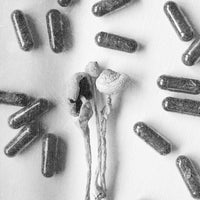What is powerful enough to turn rocks to rubble yet delicate enough to be one-cell-thick? Both intelligent enough to communicate with plants and robust enough to stitch our world together?
While that riddle may not be on par with the ones told between two hobbits in the dark, the incredible way the mycelial network connects our planet is a story worth telling.
Let's just get this straight out of the way—I’m not Paul Stamets (at least not until the court approves my name change) and it’s hard not to feel imposter syndrome writing about what he has brought to the forefront of the cultural conversation. I owe much of my interest in this subject to his research and his tellings of the incredible body of work done by other mycologists. In this field, there are so many giants to stand on the shoulders of, but I hope to do them some justice by telling this story of mycelium.
How Large Is the Mycelial Network?
Calling the organism a “mushroom” in casual conversation is usually enough to get the point across. It conjures the image of the classic mushroom cap growing in the grass or on a fallen log. In reality, the mushroom is the temporary reproductive portion of a much larger fungus. Just below the mushroom's surface (called a fruiting body) is a vast network of thin, root-like threads called the mycelium.
Mycelium is the primary form of the overall fungus. It grows throughout a substrate, such as soil, living and fallen trees, insects, and many other sources of nutrition. In favorable conditions, some mycelium can live a long time—the biggest known organism on our planet is a honey mushroom in Oregon, covering 2,200 acres and thought to be about 2,400 years old.
Not only is it big, but it’s also pretty much everywhere. In his book Mycelium Running, Stamets proposes that any land able to support life will have a mycelial network connected in an intricately woven mesh of infinitely small threads. It’s suggested that one teaspoon of healthy soil can contain 10km/6.2 miles of hyphae, the small threads that make up a mass of mycelium. One. Freakin’. Teaspoon.
What Is Mycelium and Its Purpose?
As a primary function, the mycelium anchors the fungus to its growth substrate so it can do its dirty work. The mycelial network infiltrates its food source, excreting digestive enzymes, breaking down food externally then absorbing the nutrients. Once the fungi have fully digested a substrate, what remains is highly rich in organic material, benefiting the ecosystem by spiking the soil with bioavailable nutrition that it unlocks through its unique digestive process. Somewhat morbid, but this is the premise used to create mushroom burial suits—fungal spores woven into the fabric of clothing germinate and digest our tissues, purifying us of toxins and turning us into plant food. Even if you were an asshole while alive, these mushroom burial suits give you a last shot at doing something good.
Like all living species, a fungi’s goal is to survive and reproduce. When the environment is right, the mycelium will grow fruiting bodies full of spores to reproduce blah blah blah … if this article were about fruiting bodies, we'd just show a video from any of the other brands talking about mushrooms without being genuinely passionate about their origins. But we’re here for the mycelial network! While mycelium does operate on survival of the fittest, it's also found a unique niche in nature as a symbiote.
As mentioned in our riddle above, mycelium binds our world together. As it grows throughout the environment, the mycelium comes in contact with root systems of plants, where it develops the ability to bind with the roots on a cellular level. Through this bond, there’s an exchange of mutually beneficial nutrients for each organism; the fungus receives sugars that the plant creates through photosynthesis and gets specific elements from the soil that the fungus can make available through digestion that the plant can’t perform. On top of that, the binding of the mycelium and root system stimulates an immune response in the plant—essentially flexing its immune muscle that better prepares it for potential pathogens and other blights it could encounter in the environment. The fungi that can make this bind and live in symbiosis with plants are called mycorrhiza fungi. Clever, as the name comes from fusing the Greek words for fungus and root together.
Is the Mycelial Network Conscious?
We know mycelium can cover a lot of ground (literally), so it ends up connected not just to one plant but also creates a vast mycelial network between entire ecosystems. This vast relationship has been dubbed the Wood Wide Web, a term coined by Dr. Suzanne Simard, a forest ecologist from the University of British Columbia. Throughout this network, fungi help to facilitate the transfer and storage of nutrients between plants, make bound nutrients more available and even extend the reach of roots for better water absorption. Imagine an aging tree that can give up nutrients and send them to a struggling sapling it's connected to via mycelium to facilitate growth; how is this not a Disney movie?
So your mind is already blown by this massive, interconnected farmers market going on beneath the soil. But it doesn’t end there! There’s evidence of actual communication through the mycelial network. Though a little sensationalized when reported in the news, a recent study by Dr. Andrew Adamatzky at the University of the West of England found that fungi communicate via electrical impulses sent across the mycelial network in a similar manner to neurons in our brain. The impulses seem almost like words, with various fungi composing sentences of varying complexity. What are they saying? Are they talking about the bit of spinach in your teeth? Probably. But also, it’s posited that mycelium can communicate things like finding new food sources, drought and disease to the greater community. So like a chat room. A chat room farmers market. Sign me up!
The same professor mentioned above is currently working on using mycelium as a functional component of a computer. Mycelium can generate, react and store electrical impulses and compute different logical functions by using electrical stimuli and various geometries. Will the next Mac have a mycelial network at its core? Probably not—the research is exploratory and in its infancy, but it demonstrates the power of mycelium’s ability to communicate.
With all that mycelium can do, you might be wondering, are fungi sentient? The fungal mind is aware of and responds to its environment. It communicates with countless other organisms and facilitates the growth and care of its environment. The mycelial network isn’t all that different from our brains—a series of nerves interpreting stimuli from their surroundings, generating, storing and reacting to impulses. So the next time you go out for a walk, take off your shoes and feel the dirt between your toes; maybe you, too, will feel connected to something greater.
Matt Held is MUD\WTR's Senior R&D Manager specializing in food science.
Read more: 8 Facts You Didn't Know About Paul Stamets
Read more: The Many Wonderful Mushrooms of Yunnan
Read more: What Psychedelic Researchers Are Learning About Mental Health




